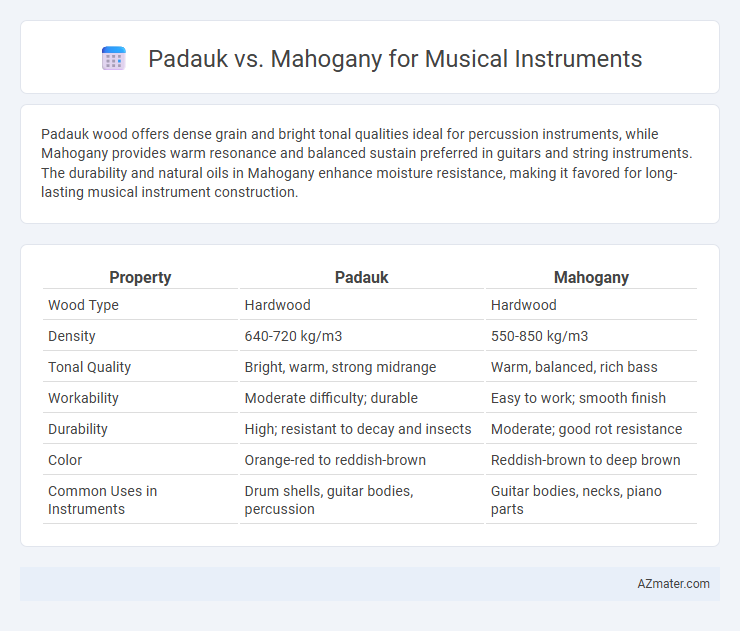Padauk wood offers dense grain and bright tonal qualities ideal for percussion instruments, while Mahogany provides warm resonance and balanced sustain preferred in guitars and string instruments. The durability and natural oils in Mahogany enhance moisture resistance, making it favored for long-lasting musical instrument construction.
Table of Comparison
| Property | Padauk | Mahogany |
|---|---|---|
| Wood Type | Hardwood | Hardwood |
| Density | 640-720 kg/m3 | 550-850 kg/m3 |
| Tonal Quality | Bright, warm, strong midrange | Warm, balanced, rich bass |
| Workability | Moderate difficulty; durable | Easy to work; smooth finish |
| Durability | High; resistant to decay and insects | Moderate; good rot resistance |
| Color | Orange-red to reddish-brown | Reddish-brown to deep brown |
| Common Uses in Instruments | Drum shells, guitar bodies, percussion | Guitar bodies, necks, piano parts |
Introduction to Padauk and Mahogany as Tonewoods
Padauk and Mahogany are prized tonewoods in musical instrument crafting due to their distinct acoustic properties and durability. Padauk offers a bright, resonant sound with strong midrange frequencies, making it ideal for guitars and percussion instruments that require clarity and projection. Mahogany provides a warm, balanced tone with pronounced low mids, favored for its rich sustain and depth in acoustic and electric guitars.
Physical Characteristics: Padauk vs Mahogany
Padauk exhibits a vibrant reddish-orange hue with a straight to interlocked grain, known for its high density and exceptional dimensional stability, making it ideal for musical instruments requiring durability and resistance to environmental changes. Mahogany features a rich reddish-brown color that darkens over time, with a fine, even grain and moderate density, offering excellent resonance and warm tonal qualities favored in guitars and violins. While Padauk's hardness enhances sustain and brightness, Mahogany's balanced weight and workability contribute to a mellow, warm sound and ease of shaping in instrument crafting.
Acoustic Properties and Sound Quality Comparison
Padauk delivers bright, crisp tones with strong midrange presence, making it ideal for instruments requiring clear articulation and projection. Mahogany offers warm, rich sound characterized by deep, resonant lows and smooth midtones, favored for enhancing sustain and balanced tonal warmth. The choice between Padauk and Mahogany significantly influences the instrument's acoustic properties, with Padauk excelling in clarity and Mahogany providing depth and warmth.
Workability and Ease of Crafting Instruments
Padauk offers excellent workability with its straight grain and medium texture, making it easier to carve and shape for detailed instrument parts. Mahogany's uniform grain and moderate density provide smooth sanding and finishing, ideal for acoustic instruments requiring precision and stability. Both woods respond well to hand and machine tools, but Padauk's less oily nature results in faster drying times and stronger glue joints during assembly.
Aesthetic Appeal: Color, Grain, and Finish
Padauk offers vibrant reddish-orange hues that deepen over time, providing a striking and warm aesthetic for musical instruments, while mahogany displays rich, reddish-brown tones known for classic elegance. The grain of padauk is typically straight and fine, with occasional interlocking patterns that add subtle visual texture, whereas mahogany features a straight, even grain that lends a smooth and consistent appearance. Both woods accept finishes well, but padauk's natural luster enhances high-gloss coatings, making it popular for visually impactful instruments, and mahogany's silky finish offers timeless beauty sought in premium guitar and piano construction.
Durability and Stability in Musical Instruments
Padauk offers exceptional durability and dimensional stability, making it highly resistant to warping and cracking in varying humidity levels, essential for maintaining sound quality in musical instruments. Mahogany is also prized for its stability and strength, providing a warm tonal quality while resisting deformation over time. Both woods are excellent choices, but Padauk's superior hardness and resilience often make it preferable for instruments requiring enhanced structural integrity.
Cost and Availability for Luthiers
Padauk offers a cost-effective alternative to mahogany for luthiers, typically priced lower due to its faster growth and wider availability. Mahogany, especially Genuine Mahogany or Honduran Mahogany, commands a higher price driven by its consistent grain, tonal warmth, and historical use in high-end instruments. While both woods are suitable for guitars and other stringed instruments, Padauk's broader availability and budget-friendly cost make it a compelling choice for luthiers balancing quality and expense.
Sustainability and Environmental Impact
Padauk offers a sustainable alternative to Mahogany, with faster growth rates and more efficient forest regeneration, reducing the environmental footprint in musical instrument production. Mahogany, often harvested from old-growth forests, faces sustainability challenges due to illegal logging and slower replenishment, raising concerns about long-term availability and habitat loss. Choosing Padauk supports eco-friendly practices while maintaining tonal quality, blending durability with reduced deforestation impact in string instruments and percussion.
Popular Instruments Made with Padauk and Mahogany
Padauk is widely used in guitar backs, sides, and fingerboards due to its bright tone and durability, especially in brands like Taylor and Martin. Mahogany is favored for acoustic guitar bodies and necks, providing warm, resonant sound favored in vintage Gibson models and classical instruments. Both woods balance tonal qualities and workability, making them popular choices in crafting string instruments and percussion.
Choosing the Right Wood: Padauk or Mahogany?
Padauk offers bright, clear tonal qualities with strong midrange projection, making it ideal for instruments requiring crisp sound and crisp attack, whereas mahogany provides warm, rich tones with excellent sustain and balanced lows, favored for acoustic guitars and resonant bodies. Padauk's dense, stable grain ensures durability and resistance to moisture, enhancing the longevity of instruments exposed to varying climates, while mahogany's workability and natural beauty contribute to both aesthetic appeal and sound quality. Musicians and luthiers should consider the desired tonal character, instrument type, and environmental conditions when choosing between padauk and mahogany for optimal performance and sound.

Infographic: Padauk vs Mahogany for Musical Instrument
 azmater.com
azmater.com